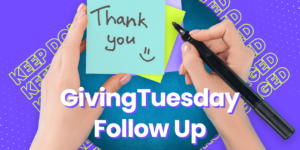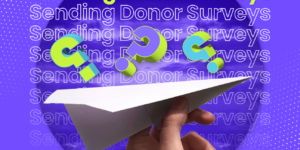Did you raise less than you expected this year-end giving season? Well, you probably want to find out what went wrong before your spring appeal. And your nonprofit’s ask string might be to blame!
You should be rewarded for creating communications that feel personal, tell a donor-centric story, and explain the impact of every donation.
Did you know much of the human decision-making process is a subconscious effort? It’s true! And understanding how the mind works and adjusting your asks accordingly is an important part of fundraising.
So, let’s explore how to approach your asks from a psychological perspective.
Rooting your asks in the science of securing support will allow you to test and gather the data you need to raise more money, improve your appeals, and change the world.
LEARN MORE: Ask strings and the science of securing support.

1. Use the center-stage effect.
It’s pretty common for nonprofits to use a three-tiered ask string. And we’re big fans of this approach. It’s natural for us to pay the most attention to what’s in the middle.
So, use this to guide your donors to that ideal gift.
It’s the Goldilocks principle in effect. Supporting your ideal ask with an option that seems too high and one that looks too small helps the donor determine the middle gift amount is “juuuuusssst right!”
And our eyes are drawn to the middle option first. But studies show the longer we look at something, the more we like it. The reverse is true as well, the more we like something, the more we look!
This is known as a feedback loop – a quirk in the human brain that fundraisers can use to their advantage. So, make sure your ideal ask is in the middle, and draw attention to it any way you can.
Use colored buttons on webpages and emails for each gift value on your nonprofit’s ask string. Make your middle choice a brighter shade than the other two. We see faster than our brains can comprehend.
Draw donors’ eyes where you want them to go. Their brain, heart, and donations will follow.
LEARN MORE: Let’s amplifi your nonprofit’s call-to-action.

2. Determining the right ask amounts.
Using a mathematical formula will help you make an ask that feels right for every donor.
And it’s a great way for nonprofits with limited data to get started since you only need to know the value of a donor’s most recent gift, or their average gift value during a fiscal year if you send multiple appeals in a year.
Our standard is to use the last gift as the low-end ask and double that number as the highest of the three. The center target ask falls right in between, subtly encouraging a donor to increase their gift by 50 percent.
Use the suggestion above for your current donors and a less aggressive ask string for donors whose last gift was some time ago.
So, if a current donor’s last gift was $100, you would present them with an ask string of $100, $150, $200. But a donor at risk of lapsing and whose last gift was also $100 would see an ask string of $75, $100, $150, while a lapsed donor would receive $50, $75, $100.
Want to take it a step further? Then, try using an audience’s giving history to create giving levels to determine pre-set formulas for your asks. These will still be based on how much a donor previously gave. But this approach will segment your audience into giving tiers to determine the right ask, rather than a specific formula for individual donors.
LEARN MORE: Applying data-driven ask strings in your appeals.

3. Make it feel real.
There are many other ways to communicate what you want donors to do subconsciously. You just need to convince them they already know what to do.
Showing donors the impact of every donation is a great way to elevate your nonprofit’s ask string. If you’re running a campaign for a specific program or initiative, you can share exactly how specific gift amounts further the cause.
So, connect dollar amounts to something more tangible. For example, asks for a youth organization’s back-to-school initiative might include:
- $50 can provide notebooks and pencils for an entire class.
- $100 can buy five backpacks for students who need them.
- $150 could buy new dry-erase boards for three classrooms.
Just remember, you want donors to buy in and support a cause that is important to them, not check off items on a shopping list.
In our example, notebooks, backpacks, and dry-erase boards are just some ways the organization furthers its mission of helping underserved students get a good education. So, make sure you connect the dots with a mission-focused approach.
LEARN MORE: The right way to compare dollars to impact.
It’s not a simple science.
An inferior ask string can doom even the most well–planned and executed appeal. Yet, many nonprofits are unaware of the science behind making the ask and how to use it to raise more money.
The strategies we covered in this blog post can help. But there’s a lot more to it!


![[amplifi] - eBook pop ups and banners _Ask Strings (blog) FREE eBOOK: Ask strings and the science of securing support.](https://amplifinp.com/wp-content/uploads/2022/03/amplifi-eBook-pop-ups-and-banners-_Ask-Strings-blog.png)






